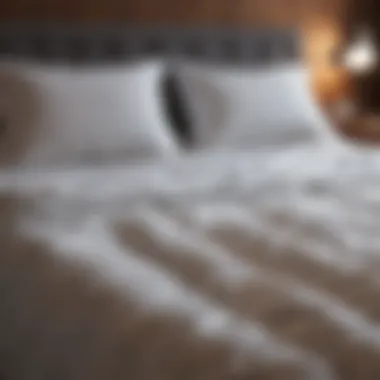Exploring the Best Cooling Duvet: Your Comprehensive Guide


Intro
In the age of heightened climate awareness and personal comfort, the choice of bedding has evolved significantly. Among the various elements influencing sleep quality, cooling duvets stand out as a practical solution for those seeking comfort during warmer months. As temperatures rise, the right duvet can significantly contribute to a restful night, ensuring that one does not awaken drenched in sweat or feeling overheated.
This guide presents a comprehensive look into the best cooling duvets currently available. It encompasses essential factors to contemplate when selecting a duvet, including material properties, functional characteristics, and expert suggestions, all aimed at improving overall sleep quality. With insights in temperature regulation, ideal features, and product reviews, readers are expected to walk away with a well-rounded perspective on how to upgrade their sleep environment.
Moreover, understanding the science surrounding bedding can aid consumers in making informed choices. A thorough analysis will empower one to discern which duvet is most appropriate for their unique needs. Whether one is an intricate sleeper or simply enjoys curated comfort, the options available today unlock new potential for sleep enhancement. Now, let's embark on this exploration together.
Prelude to Cooling Duvets
In the pursuit of restorative sleep, the choice of bedding plays a critical role. Cooling duvets have emerged as a popular option for individuals seeking comfort and temperature regulation. They offer specialized features that help manage body heat during the night, a significant element for quality rest. This section provides an overview of cooling duvets, their function, and why they matter for a good sleep experience.
Understanding Duvets
Duvets are essentially blankets filled with insulating materials. They are used as the top layer of bedding and provide warmth while offering a level of comfort. Typically, a duvet consists of a soft, protective cover that encases the filling, which can include natural down or synthetic fibers. The construction influences how well the duvet can retain warmth, its weight, and its overall feel.
Cooling duvets differ as they are specifically designed with temperature regulation in mind. They use lightweight materials that promote airflow and wick moisture away from the body. This creates a more comfortable sleeping environment, especially in warmer climates or for those who sleep hot.
Importance of Temperature Control
Maintaining a stable body temperature while sleeping is crucial for achieving a restful night. If the body overheats, it can lead to discomfort and disrupted sleep patterns. This is where cooling duvets come in. They are engineered to allow heat to escape while preventing cold from taking over, helping to regulate temperature effectively throughout the night.
The benefits of temperature control extend beyond just comfort. Good sleep quality has been linked to improved overall wellness, including better cognitive function, mood stability, and even physical health. By incorporating the right cooling duvet into your bedding, you not only enhance personal comfort but also support healthy sleep habits.
A well-chosen cooling duvet can mean the difference between restless tossing and turning or deep, uninterrupted slumber.
"Investing in the right bedding is a step toward improving sleep quality, which is fundamental to overall health."
In sum, understanding duvets and temperature control is vital when selecting bedding. With various options available, a cooling duvet can serve as a beneficial addition to any sleep environment.
The Science Behind Temperature Regulation
Temperature regulation in bedding is a complex yet crucial factor that influences both comfort and sleep quality. The function of a duvet goes beyond mere warmth; it plays a significant role in helping the body maintain an optimal temperature throughout the night. Understanding this science allows consumers to make more informed decisions when selecting a cooling duvet that suits their needs.
Body Heat and Sleep Quality
During sleep, our body naturally fluctuates in temperature. It is essential for sleep quality that the body neither becomes too hot nor too cold. When it is too warm, individuals may experience discomfort, restlessness, or even wakefulness. High temperatures can disrupt the natural sleep cycle, leading to reduced restorative sleep.
Cooling duvets are designed to manage body heat effectively. They create a microclimate that helps wick moisture and dissipate heat away from the body. This results in an environment conducive to deep sleep. Studies indicate that maintaining a cooler body temperature can enhance the quality of sleep, allowing individuals to enter REM cycles more efficiently and wake up feeling refreshed.
"The ability to regulate body heat is key to achieving a restful night’s sleep."
Material Breathability
Material breathability refers to how well a fabric allows air to flow through it. This feature is essential in cooling duvets, as it directly affects comfort and temperature regulation. Fabrics such as cotton, linen, and specialized synthetic blends are popular for their breathability.


Breathable materials facilitate air circulation, promoting a cooling effect and allowing moisture to escape. This is particularly important for individuals who tend to sweat during sleep. Choosing a duvet made from highly breathable materials can significantly reduce the sensation of heat buildup during the night.
In summary, understanding the science of temperature regulation and how cooling duvets work is vital for anyone looking to enhance their sleep quality. Recognizing the impact of body heat and the role of material breathability will guide homeowners and design enthusiasts towards selecting the right bedding solution.
Key Features of a Cooling Duvet
Understanding the key features of a cooling duvet is essential when seeking an optimal sleep environment. These features can significantly influence comfort, thermal regulation, and overall sleep quality. Cooling duvets are designed not just for aesthetics but also for functionality, ensuring that the user enjoys restful nights while managing body heat. This section delves into the specific characteristics that distinguish a good cooling duvet from its traditional counterparts.
Material Composition
The material composition of a cooling duvet plays a vital role in its ability to regulate temperature. Fabrics like Tencel, bamboo, and certain synthetic blends are especially popular for their breathable nature. These materials allow air circulation, which aids in dissipating heat. A duvet filled with down or alternative down can also impact its cooling properties.
For instance, natural fibers like cotton often have better moisture absorption, which helps in managing sweat, while synthetic options may offer additional durability and ease of care. The choice of material can also affect the weight of the duvet, which is another crucial aspect of comfort during sleep. Consider these attributes to ensure your selected cooling duvet aligns with your personal comfort preference.
Weight and Loft
Weight and loft are significant in determining how a duvet feels during use. Lightweight duvets tend to feel more airy and can provide a comfortable sleeping experience in warmer climates. On the other hand, heavier duvets often yield a cozy feeling but may not be suitable for hot weather. Loft refers to the thickness of the duvet. A higher loft can create an insulative layer that traps warm air, which may not be ideal if the goal is to stay cool.
Therefore, selecting a duvet with the right balance of weight and loft is crucial. Often, a mid-range loft works best, providing sufficient support without feeling bulky. It is advisable to consider your individual sleeping habits and the climate in which you reside when evaluating these aspects.
Moisture-Wicking Properties
Moisture-wicking properties are another essential feature for those who tend to sweat at night. Effective moisture-wicking materials can draw sweat away from the body, promoting a drier and more comfortable sleeping experience. Fabric technology has advanced considerably, with many brands now integrating moisture-wicking fibers to enhance the overall performance of their duvets.
For example, polyester blends often exhibit this characteristic effectively. This feature is particularly beneficial in humid conditions, as it helps maintain a balanced body temperature. When exploring duvet options, prioritize those specifically designed with moisture management in mind.
Hypoallergenic Features
Hypoallergenic features should not be overlooked, especially if you have sensitivities or allergies. Certain materials, such as polyester or natural latex, resist dust mites and other allergens, making them preferable for allergy sufferers. Brands often highlight these features, providing additional peace of mind for those concerned about sleep hygiene.
In addition to selecting hypoallergenic materials, ensure proper care and maintenance of the duvet. Regular washing following manufacturer guidelines can help maintain its hypoallergenic properties. Remember that a truly comfortable duvet not only fits well but also supports your health by mitigating allergy symptoms.
By focusing on material composition, weight and loft, moisture-wicking properties, and hypoallergenic features, consumers can make informed decisions about which cooling duvet is right for them. Each of these factors contributes to the ability of a duvet to provide a comfortable and restorative sleep environment.
Comparative Analysis of Top Cooling Duvets
In the quest for optimal sleep, cooling duvets offer a substantial advantage. The importance of comparing various options lies in understanding how different materials, designs, and features impact not only comfort but also overall sleep quality. Each duvet has unique elements that can contribute differently. By examining each product, consumers can identify which duvet aligns best with their specific sleep needs and preferences. This section will analyze four notable options, focusing on materials, unique features, performance reviews, and customer feedback.
Duvet A: Materials and Benefits
Duvet A utilizes a blend of lyocell and cotton, known for its softness and breathability. Lyocell, derived from natural fibers, aids in temperature regulation by allowing body heat to escape, thus preventing overheating. The cotton adds durability and a pleasant feel. This duvet is often praised for its lightweight design, making it suitable for warm climates. The hypoallergenic properties also protect against dust mites, which is a plus for allergy sufferers.
Duvet B: Unique Features
What sets Duvet B apart are its specialized cooling gel-infused fibers. These fibers actively absorb heat from the body during sleep, cooling the surface of the duvet. This innovative approach ensures a consistently comfortable sleep experience, especially in warmer months. Furthermore, Duvet B includes adjustable loft design, allowing users to modify the thickness to their liking. This adaptability appeals to a wide range of sleepers.


Duvet C: Performance Review
Duvet C stands out in performance tests, demonstrating excellent moisture-wicking capabilities. Conducted studies show it retains less moisture than traditional duvets, which helps to reduce sweat buildup. It's worth noting that this duvet's breathability contributes to its effectiveness, ensuring a comfortable sleep environment. Users often report improved sleep quality and less disruption due to overheating during the night.
Duvet D: Customer Feedback
Customer feedback for Duvet D highlights its superior comfort and aesthetic appeal. Many users appreciate the elegant design, which complements various bedroom styles. Additionally, reviews consistently mention the lightweight nature of this duvet, making it easy to handle and maintain. On platforms like reddit.com, discussions often revolve around how customers would recommend this duvet for anyone seeking a blend of style and function in their bedding.
"After switching to Duvet D, I have noticed a significant improvement in my sleep quality. It feels like I am wrapped in a cool cloud every night!"
By analyzing these duvets, individuals can make an informed choice based on their preferences, whether prioritizing materials, innovative features, performance, or overall satisfaction derived from customer experiences.
How to Choose the Right Cooling Duvet for Your Needs
Selecting the appropriate cooling duvet can significantly impact your sleep quality. The right duvet can help maintain your body temperature at an ideal level during sleep, avoiding uncomfortable heat retention. As temperatures fluctuate, ensuring a suitable duvet promotes a comfortable sleep environment. Hence, understanding how to choose the right cooling duvet is crucial.
Assessing Personal Comfort Preferences
Comfort is subjective. Each individual has distinct preferences. When evaluating a cooling duvet, ask yourself:
- Do you prefer lightweight or heavier materials? Some individuals find a lighter duvet offers breathability while others seek that cozy weight.
- What fabric feels best against your skin? Options like cotton and bamboo offer different sensations. Cotton is breathable while bamboo can have a silky finish.
By determining these preferences, you can narrow down your options. Getting the feel of the duvet in-store or checking online reviews can aid your decision.
Climate Considerations
Your local climate plays a critical role in selecting a duvet. Different materials perform better in various temperatures. For those in warmer regions, a duvet filled with a blend of cooling fibers and breathable materials, like Tencel, works well. It can effectively wick away moisture.
In contrast, if you reside in cooler climates, you may need a duvet that balances warmth and breathability. Many all-season duvets provide versatility, adapting to changing temperatures effectively. Understanding your climate needs enables you to make a well-informed choice.
Budget Factors
Budget influences duvet selection. Cooling duvets vary in price based on materials, brand, and technology used. High-end options often employ advanced materials that offer exceptional comfort and durability. However, numerous mid-range options provide competent cooling properties.
- Set a clear budget before starting your search.
- Research different brands and reviews to find options within your budget that meet your criteria.
Quality matters. Moderately priced options may still provide substantial value, but avoid overly cheap products that may not perform effectively. It could lead to discomfort, jeopardizing your sleep quality.
Care and Maintenance of Cooling Duvets
Maintaining a cooling duvet is crucial for ensuring its longevity and performance. Just like any other bedding product, proper care can greatly enhance its effectiveness, keeping you comfortable while you sleep. Neglecting to care for your duvet can lead to decreased performance, unwanted odors, or even damage to the materials.
Take note of the specific care instructions as per the manufacturer’s guidelines. This will help you preserve the unique properties of the materials used in your duvet.
Washing Instructions


Cleaning your cooling duvet accurately is important. Most cooling duvets are machine washable, but you should verify this first. Here are some key cleaning steps to follow:
- Check the label: Always read the care label before washing. This will advise you if your duvet is machine washable or requires special cleaning.
- Use a gentle cycle: When washing, opt for a gentle cycle to avoid damaging the fabric.
- Cold water: Use cold water for washing. Hot water can damage materials and cause shrinkage.
- Mild detergent: Select a mild detergent that is free of harsh chemicals. This will help in keeping the duvet fresh without degrading the fabric.
- Rinse thoroughly: Ensure that you rinse out all soap residue to prevent buildup that may irritate your skin.
After washing, proper drying is also important. You can dry your duvet in a dryer on low heat. Add clean tennis balls or dryer balls to fluff it up and maintain its loft.
Storage Tips
When not in use, proper storage ensures that your cooling duvet remains in good condition. Here are some effective storage tips:
- Choose a cool dry place: Store your duvet in a moisture-free environment to prevent mold and mildew buildup.
- Use a breathable storage bag: Opt for a cotton or linen storage bag that allows air circulation. Avoid plastic bags, as they can trap moisture.
- Avoid folding: If possible, roll your duvet instead of folding it. This can help prevent creases that can affect its loft and comfort.
- Check periodically: It's wise to check your stored duvet occasionally. This helps to catch any signs of damage or mold before reuse.
Proper care and maintenance can extend the lifecycle of your cooling duvet, ensuring it continues to regulate temperature effectively.
Sleeping Environment: Enhancing Your Space
Creating the right sleeping environment is crucial for achieving quality rest. A well-designed space can positively influence sleep hygiene and reduce disturbances. In this section, we will examine key elements that contribute to a more comfortable and restful sleep area. This involves not just the choice of a cooling duvet but also other aspects of the sleeping environment that foster relaxation and comfort.
Bedding Accessories
Bedding accessories play an important role in enhancing sleep comfort. Items like mattress protectors and pillowcases impact overall sleep quality.
- Mattress Protectors: They keep your mattress clean and extend its life. Choosing a breathable material allows for better air circulation, promoting a more temperate sleep surface.
- Pillows: Selecting the right pillow is vital. Options like memory foam or latex can support the neck and spine in an optimal position, avoiding morning stiffness.
- Topper: Adding a cooling mattress topper can enhance the comfort level by regulating the heat that builds up during the night. This complements the functionality of a cooling duvet.
- Luxury Bedding: Investing in high-quality sheets made from materials like bamboo or cotton can improve breathability and moisture absorption, contributing to a better sleep experience.
These accessories, when selected properly, can elevate your sleep environment significantly.
Room Temperature Regulation
The regulation of room temperature is fundamental to maintaining a comfortable sleeping atmosphere. A cool room contributes to improved sleep cycles and overall health. Here are some considerations:
- Ideal Temperature: The optimal sleep environment typically ranges between 60 to 67 degrees Fahrenheit. Maintaining this range can enhance sleep quality.
- Air Conditioning and Heating: Using air conditioning units in summer and heating systems in winter helps regulate indoor temperatures effectively. However, be mindful of settings that may cause temperature fluctuations.
- Fans: Ceiling or portable fans can help with air circulation without drastically changing the room's temperature. This can prevent hot spots and create a more uniform temperature across the sleeping area.
- Windows and Insulation: Pay attention to window treatments. Blackout curtains or shades minimize light intrusion that can affect sleep. Likewise, well-insulated windows help control external temperature variations.
- Bedding Choices: As covered previously, using cooling duvets and breathable sheets is another way to control temperature while you sleep.
"A comfortable sleep environment is not just about the bed, but all elements working together to promote restful sleep."
Enhancing your sleeping environment through thoughtful selection of bedding accessories and maintaining an optimal room temperature can lead to significant improvements in sleep quality. By integrating these considerations, you create a sanctuary that embraces relaxation.
The End
In this article, we have delved into the intricacies of cooling duvets and their vital role in optimizing sleep quality. Understanding how materials work together to dissipate heat is crucial for anyone seeking a better night's rest. Given the myriad of options now available, selecting the right duvet demands attention to various factors, including personal comfort preferences and budget considerations.
One significant takeaway is how a cooling duvet can not only enhance sleep but also overall well-being. A lower sleeping temperature is linked to improved sleep cycles and deeper rest. In a market flooded with choices, recognizing key features such as moisture-wicking capabilities and the duvet's breathable composition can greatly assist in making informed decisions.
Additionally, maintaining these duvets properly ensures their longevity. Proper care, such as adhering to washing instructions and utilizing storage tips, can make a significant difference in the durability of your purchase.
Ultimately, investing in a quality cooling duvet is a practical step towards creating a sleep-friendly environment. With the insights provided throughout this guide, readers are now equipped to choose effectively among the best cooling duvets available.
Summary of Key Points
- Cooling duvets are essential for maintaining a comfortable sleep temperature, leading to better sleep quality.
- Material composition impacts breathability and heat regulation.
- Important features include weight, loft, and moisture-wicking properties.
- Customer feedback is vital in assessing the real-world performance of different duvets.
- Proper care and maintenance extend the lifespan and efficacy of cooling duvets.
"A well-chosen cooling duvet can dramatically influence your sleep environment and health.”















